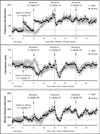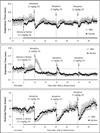Low-dose morphine elicits ventilatory excitant and depressant responses in conscious rats: Role of peripheral μ-opioid receptors
- PMID: 24900948
- PMCID: PMC4041292
- DOI: 10.4236/ojmip.2013.33017
Low-dose morphine elicits ventilatory excitant and depressant responses in conscious rats: Role of peripheral μ-opioid receptors
Abstract
The systemic administration of morphine affects ventilation via a mixture of central and peripheral actions. The aims of this study were to characterize the ventilatory responses elicited by a low dose of morphine in conscious rats; to determine whether tolerance develops to these responses; and to determine the potential roles of peripheral μ-opioid receptors (μ-ORs) in these responses. Ventilatory parameters were monitored via unrestrained whole-body plethysmography. Conscious male Sprague-Dawley rats received an intravenous injection of vehicle or the peripherally-restricted μ-OR antagonist, naloxone methiodide (NLXmi), and then three successive injections of morphine (1 mg/kg) given 30 min apart. The first injection of morphine in vehicle-treated rats elicited an array of ventilatory excitant (i.e., increases in frequency of breathing, minute volume, respiratory drive, peak inspiratory and expiratory flows, accompanied by decreases in inspiratory time and end inspiratory pause) and inhibitory (i.e., a decrease in tidal volume and an increase in expiratory time) responses. Subsequent injections of morphine elicited progressively and substantially smaller responses. The pattern of ventilatory responses elicited by the first injection of morphine was substantially affected by pretreatment with NLXmi whereas NLXmi minimally affected the development of tolerance to these responses. Low-dose morphine elicits an array of ventilatory excitant and depressant effects in conscious rats that are subject to the development of tolerance. Many of these initial actions of morphine appear to involve activation of peripheral μ-ORs whereas the development of tolerance to these responses does not.
Keywords: conscious rats; minute ventilation; morphine; peripheral and central opioid receptors; tolerance.
Conflict of interest statement
None.
Figures




References
-
- Oguri K, Yamada-Mori I, Shigezane J, Hirano T, Yoshimura H. Enhanced binding of morphine and nalorphine to opioid delta receptor by glucuronate and sulfate conjugations at the 6-position. Life Sciences. 1987;41:1457–1464. - PubMed
-
- Frances B, Gout R, Campistron G, Panconi E, Cros J. Morphine-6-glucuronide is more μ-selective and potent in analgesic tests than morphine. Progress in Clinical Biological Research. 1990;328:477–480. - PubMed
-
- Frances B, Gout R, Monsarrat B, Cros J, Zajac JM. Further evidence that morphine-6 beta-glucuronide is a more potent opioid agonist than morphine. Journal of Phrmacology and Experimental Therapeutics. 1992;262:25–31. - PubMed
-
- Chen ZR, Irvine RJ, Somogyi AA, Bochner F. Mu receptor binding of some commonly used opioids and their metabolites. Life Sciences. 1991;48:2165–2171. - PubMed
-
- Christensen CB, Reiff L. Morphine-6-glucuronide: Receptor binding profile in bovine caudate nucleus. Pharmacology and Toxicology. 1991;68:151–153. - PubMed
Grants and funding
LinkOut - more resources
Full Text Sources
Other Literature Sources
Research Materials
